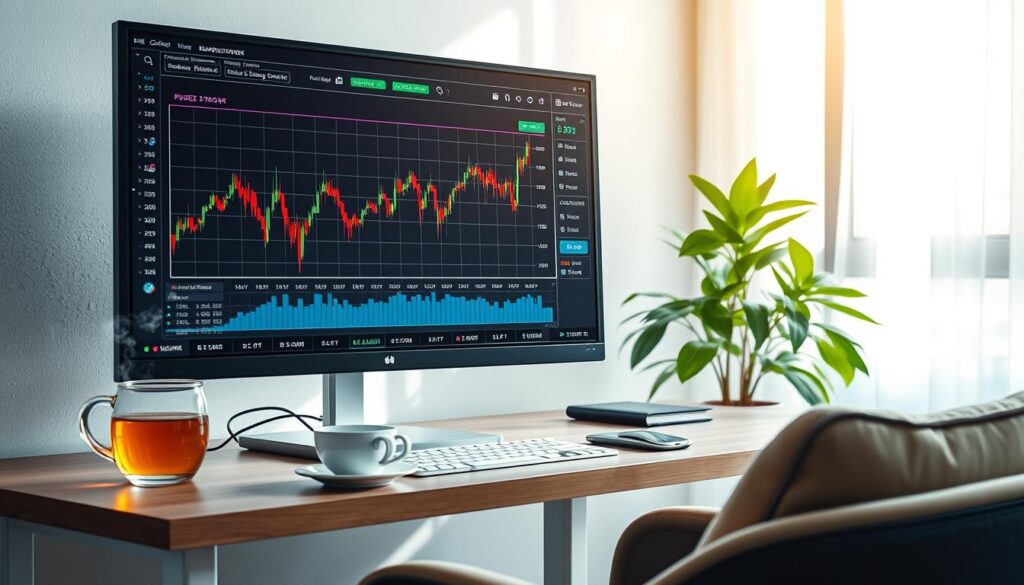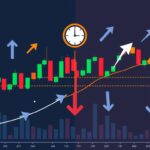Overtrading prevention is crucial for traders to avoid significant financial losses. It refers to the excessive buying and selling of stocks, which can lead to spending excess money on commissions and compounding risks. To achieve capital protection, traders must understand the importance of trading discipline and its impact on trading performance.
Recognizing the need to step away and take a break from trading activities can help in avoiding overtrading and regaining control over decision-making processes. Cash is regarded as a protective position in trading, providing a buffer against overtrading tendencies. For more information on money management rules, visit trading rules to learn how to protect your capital.
Table of Contents
Key Takeaways
- Overtrading can lead to significant financial losses, including excess commissions and compounding risks.
- Trading discipline is essential for capital protection and achieving long-term profitability.
- Recognizing the need to step away and take breaks from trading can help avoid overtrading.
- Cash can provide a buffer against overtrading tendencies.
- Implementing a weekly trade limit can enhance trading performance and encourage effective planning.
- Focusing on consistent monthly and yearly profits is key to achieving long-term profitability.
Understanding the Dangers of Overtrading
Overtrading is a common pitfall that can have severe consequences on a trader’s capital risk. It is essential to understand the overtrading definition and its implications on trading activities. Overtrading occurs when a trader engages in excessive buying and selling without a logical reason, often driven by emotions.
This behavior can lead to serious financial losses, as traders may end up taking on too much capital risk. To avoid overtrading, it is crucial to identify common trading triggers, such as lacking a trading plan or experiencing fear of missing out (FOMO). By recognizing these triggers, traders can develop strategies to prevent overtrading and protect their capital.
What Defines Overtrading
Overtrading is characterized by impulsive decisions, often driven by emotions rather than rational thinking. It can lead to a significant increase in transaction costs, eroding profits and increasing capital risk. Traders who engage in overtrading may experience a decline in their win rate, as they are more likely to make impulsive decisions.
Common Triggers of Overtrading
Some common triggers of overtrading include:
- Lacking a trading plan
- Revenge trading after losses
- Fear of missing out (FOMO)
- Excessive focus on profit and loss (PnL)
Impact on Trading Capital
Overtrading can have a significant impact on trading capital, leading to increased capital risk and potential financial losses. Traders who engage in overtrading may experience a decline in their trading performance, as they are more likely to make impulsive decisions. By understanding the dangers of overtrading and developing strategies to prevent it, traders can protect their capital and achieve long-term trading success.
The Psychology Behind Excessive Trading
Trading psychology plays a significant role in the decisions traders make, and it can often lead to overtrading. Emotional trading behaviors, such as fear and greed, can drive traders to make irrational decisions, resulting in excessive buying and selling of financial instruments. Behavioral finance suggests that traders are prone to cognitive biases, such as loss aversion and the fear of missing out (FOMO), which can significantly impact trading decisions.
Research indicates that many retail traders tend to overestimate their market knowledge, resulting in excessive trading activity. This can lead to a pattern of frequent trades that incur high transaction costs and emotional exhaustion, deviating traders from structured trading plans. To avoid overtrading, it is essential to understand the psychological aspects that contribute to it and develop emotional intelligence to manage these emotions.
Some key strategies to prevent overtrading include implementing risk management techniques, setting clear limits on trade volume and frequency, and leveraging technology. Additionally, engaging in mindfulness practices like meditation, keeping a trading journal, and building support networks with peers and mentors can help address emotional impulses in trading. By recognizing the psychological factors that contribute to overtrading and taking steps to manage them, traders can develop a more balanced mindset and make more informed decisions.
Quality over quantity is advised for traders to focus on the quality of trades rather than quantity, aiming for moderate yet consistent returns. It is noted that only 20-30 trades out of 200 trading days are deemed perfect, translating to placing one trade approximately every six days to avoid overtrading. By understanding trading psychology and behavioral finance, traders can better navigate the markets and make more informed decisions to achieve their goals.
Warning Signs You’re Trading Too Much
Recognizing overtrading symptoms is crucial to protecting your capital. One telltale sign is having multiple small positions open concurrently without a specific plan for each trade. This can lead to trading red flags such as increased transaction costs and a declining win rate.
Effective portfolio management involves being aware of these warning signs and taking steps to mitigate them. Some key indicators of overtrading include:
- Emotional decision-making, leading to impulsive trades
- Increased transaction costs, eating into profits
- Declining win rate, indicating a need to reassess trading strategies
- Portfolio volatility spikes, suggesting a lack of diversification
By acknowledging these signs and adjusting your trading approach, you can better manage your portfolio and avoid the pitfalls of overtrading.
| Warning Sign | Description |
|---|---|
| Emotional Decision-Making | Trading based on emotions rather than analysis |
| Increased Transaction Costs | Higher costs due to frequent buying and selling |
| Declining Win Rate | A decrease in successful trades over time |
| Portfolio Volatility Spikes | Sudden increases in portfolio value fluctuations |
Creating a Sustainable Trading Schedule
Developing a sustainable trading routine is crucial for maintaining discipline and preventing impulsive trading decisions. A well-structured trading routine allows investors to reassess their strategies and ensure they fit their overall investment objectives. Effective time management is also essential for balancing trading with other life commitments.
To create a sustainable trading schedule, consider the following tips:
- Set specific trading hours to avoid overtrading and minimize distractions.
- Take regular breaks to reduce stress and decision fatigue.
- Align trading activities with personal energy levels and market conditions.
By prioritizing time management and creating a trading routine that works for you, you can reduce the risk of overtrading and achieve more consistent results. Remember, sustainable trading is about finding a balance between trading and other aspects of your life.
| Trading Schedule | Benefits |
|---|---|
| Set specific trading hours | Reduces distractions and minimizes overtrading |
| Take regular breaks | Reduces stress and decision fatigue |
| Align trading with energy levels and market conditions | Improves trading performance and reduces risk |
Risk Management Strategies to Prevent Overtrading
Effective risk management is crucial in preventing overtrading, which can lead to significant losses and negatively impact overall trading performance. By implementing proper position sizing guidelines, traders can diffuse the likelihood of a large drawdown, reducing the psychological pitfalls that come from such circumstances.
A key aspect of risk management is setting loss limits, which helps maintain trading discipline. This can be achieved by determining daily loss limits and adhering to them. Additionally, portfolio allocation rules can help diversify risk and reduce the temptation to overtrade.
- Determine the optimal position size based on account balance and risk tolerance
- Set daily loss limits to maintain trading discipline
- Establish portfolio allocation rules to diversify risk
By incorporating these risk management strategies, traders can prevent overtrading and protect their capital. Remember, risk management is an ongoing process that requires continuous monitoring and adjustment to ensure optimal trading performance.
How to Avoid Overtrading in Volatile Markets
Market volatility can be a significant challenge for traders, as it may lead to impulsive decisions and overtrading. To avoid this, it’s essential to maintain trading discipline and emotional control. One approach is to limit the number of trades and create a clear trading plan with specific entry and exit points.
In volatile markets, market volatility can result in significant losses or margin calls with even small price changes. To mitigate this risk, traders should establish risk tolerance, keep leverage to a minimum, and understand potential losses before using borrowed money. Neglecting risk management can lead to significant losses, particularly in times of high market volatility.
Some strategies to avoid overtrading in volatile markets include:
- Spreading the risk by diversifying holdings and avoiding being overexposed to any single market or asset class
- Setting stop-loss orders and following a well-defined trading plan with clear entry and exit strategies
- Implementing the ’20-minute rule’ before entering a trade to ensure trading decisions are based on strategy rather than emotion
By maintaining trading discipline and emotional control, traders can avoid overtrading and make more informed decisions, even in the most turbulent markets. As the saying goes, “patience is a virtue,” and this is particularly true in market volatility situations.
Developing a Strategic Trading Plan
A well-developed trading plan is crucial in preventing overtrading. This plan should include clear entry rules and exit strategies based on technical and fundamental analysis. By defining your trade criteria, you can determine if you actually have a trade on your hands or if you are forcing a trade.
When creating a trading plan, consider the following key elements:
- Define your trading goals and risk tolerance
- Establish clear entry and exit rules
- Set realistic profit targets and stop-loss levels
A good trading plan should also include time-based trading restrictions to avoid impulsive decisions. Additionally, market condition analysis can help you understand when to be more active and when to step back. By incorporating these elements into your trading plan, you can develop a strategic approach to trading that helps you achieve your goals.
Remember, a trading plan is a flexible, evolving document that grows with your experience. By regularly reviewing and refining your plan, you can stay on track and avoid the pitfalls of overtrading.
| Trading Plan Element | Description |
|---|---|
| Entry Rules | Clear criteria for entering a trade |
| Exit Strategies | Plan for exiting a trade, including profit targets and stop-loss levels |
| Time-Based Trading Restrictions | Rules for avoiding impulsive decisions based on time |
The Role of Trading Technology
Trading technology plays a crucial role in preventing overtrading. With the help of trading software, traders can automate their trades, set risk management tools, and monitor their accounts more efficiently. This helps to reduce emotional decision-making and minimize the risk of overtrading.
Some popular trading platforms offer features such as automation, which allows traders to set specific rules for entering and exiting trades. These platforms also provide risk management tools that help traders to set stop-loss orders, limit orders, and other risk management strategies.
- Automated trading systems to reduce emotional decision-making
- Risk management tools to minimize losses
- Trade planning and execution features to help traders stick to their plans
By utilizing trading technology, traders can develop a more disciplined approach to trading, which is essential for avoiding overtrading. It’s essential to find a balance between using technology and understanding the underlying trading strategies to ensure long-term success.
Implementing Cool-Down Periods
Recognizing when to step away from trading is crucial to maintaining a healthy trading psychology. Taking regular trading breaks can help prevent overtrading, which can lead to significant losses. By incorporating cool-down periods into your trading routine, you can reduce the risk of burnout and improve your overall mental recovery.
A well-defined trading plan should include strategies for managing emotions and avoiding excessive trading. This can include setting daily loss limits, taking regular breaks, and engaging in physical activities to reduce stress. By prioritizing mental recovery and taking trading breaks, you can return to trading with a clear mind and make more informed decisions.
When to Step Away
It’s essential to recognize the signs that indicate it’s time to step away from trading. These can include emotional distress, a string of losses, or a significant increase in trading activity. By taking a break and focusing on mental recovery, you can regain control of your trading and make more rational decisions.
Recovery Strategies
Effective recovery strategies can include mindfulness techniques, such as meditation or deep breathing, to help manage stress and emotions. Engaging in physical activities, such as exercise or yoga, can also help reduce stress and improve mental clarity. By incorporating these strategies into your trading routine, you can improve your trading psychology and reduce the risk of overtrading.
By prioritizing mental recovery and taking regular trading breaks, you can improve your overall trading performance and reduce the risk of burnout. Remember, taking breaks is a sign of strength and professional discipline, not weakness. By incorporating cool-down periods into your trading routine, you can maintain a healthy trading psychology and achieve long-term success.
Building Discipline in Your Trading Routine
Developing trading discipline is crucial for achieving success in the markets. It involves creating a set of rules and sticking to them, even when emotions run high. One effective way to build discipline is through habit formation, where traders establish a consistent daily routine that includes pre-trade checks, market analysis, and post-trade reviews.
A key aspect of trading discipline is consistency. This means setting specific, measurable, attainable, relevant, and time-bound (SMART) trading objectives and adhering to them. It also involves managing risk through position sizing and stop-loss orders, which helps to control emotions and maintain a clear head. Some traders follow the one-percent rule, which limits the amount of capital risked on each trade to 1% of their overall portfolio.
Establishing a consistent trading routine can help limit emotion-driven decisions, promoting discipline, focus, and lower stress levels among traders. This can include activities such as:
- Regular market analysis
- Trade journaling
- Performance tracking
- Ongoing education and improvement
By cultivating trading discipline and consistency, traders can improve their chances of success and achieve their long-term goals. As the saying goes, “discipline is the bridge between goals and accomplishment.” By building strong habits and sticking to a well-planned strategy, traders can overcome common pitfalls and stay on the path to profitability.
Record Keeping and Trade Analysis
Effective record keeping is essential for traders to identify areas of improvement and optimize their trading strategies. A trading journal is a valuable tool that helps traders track their performance and make data-driven decisions. By maintaining a detailed record of their trades, traders can analyze their strengths and weaknesses, and develop a plan for self-improvement.
A well-structured trading journal should include key metrics such as trade frequency, win rate, and risk-reward ratios. These metrics provide valuable insights into a trader’s performance and help identify patterns of overtrading. Regular performance analysis is crucial to refine trading strategies and improve overall performance.
To get the most out of a trading journal, traders should schedule regular reviews to assess their progress and adjust their strategies as needed. This process of regular review and analysis is an essential part of self-improvement and helps traders stay focused on their goals. By combining a trading journal with regular performance analysis, traders can develop a robust framework for continuous improvement and optimize their trading results.
Best Practices for Maintaining a Trading Journal
- Record every trade, including the date, time, and details of the trade
- Track key metrics such as trade frequency, win rate, and risk-reward ratios
- Regularly review and analyze trading performance to identify areas for improvement
By following these best practices and incorporating a trading journal into their daily routine, traders can take a significant step towards improving their trading skills and achieving long-term success.
Managing Trading FOMO
Trading in the financial markets can be a high-stakes game, and the fear of missing out (FOMO) can be a significant obstacle to success. FOMO can lead to emotional trading, causing traders to make impulsive decisions based on emotions rather than a well-thought-out strategy. This can result in overtrading, which can quickly deplete a trading account.
To manage FOMO, traders need to develop market patience and stick to their trading plan. This includes setting clear goals, identifying potential trades, and waiting for the right moment to enter the market. A well-structured trading plan can help traders avoid emotional trading and make more informed decisions.
Some strategies for managing FOMO include:
- Setting realistic goals and expectations
- Developing a trading plan and sticking to it
- Practicing market patience and waiting for the right trading opportunities
- Using technical analysis and risk management tools to inform trading decisions
By managing FOMO and developing a disciplined trading approach, traders can reduce their risk of overtrading and improve their overall trading performance. It’s essential to remember that trading is a marathon, not a sprint, and market patience is key to long-term success.
| Strategy | Benefits |
|---|---|
| Setting realistic goals | Reduces emotional trading, increases focus |
| Developing a trading plan | Helps traders stick to their strategy, avoid impulsive decisions |
| Practicing market patience | Allows traders to wait for the right opportunities, reduce overtrading |
Alternative Approaches to Active Trading
For traders looking to reduce their screen time and emotional involvement, alternative approaches to active trading can be beneficial. Passive investing strategies, such as index funds or ETFs, can provide broad diversification and lower fees. This approach can be particularly appealing to those who want to minimize their involvement in the market while still benefiting from its potential for growth.
Another option is algorithmic trading, which uses computer programs to execute trades based on predefined criteria. This approach can help remove emotions from trading decisions and improve efficiency. However, it requires a significant amount of upfront work to develop and test the trading algorithm.
Long-term Investment Strategies
Long-term investment strategies focus on holding assets for an extended period, often years or decades. This approach can help investors ride out market fluctuations and benefit from the power of compounding. Diversification is key to successful long-term investing, as it helps to reduce risk and increase potential returns.
Automated Trading Solutions
Automated trading solutions, such as robo-advisors, can provide a convenient and low-cost way to invest in the market. These platforms use algorithms to diversify portfolios and minimize risk. While they can be a good option for beginners or those with limited investment experience, it’s essential to carefully evaluate their fees and investment strategies before investing.
Conclusion: Mastering Self-Control for Trading Success
As we conclude this journey, the key lesson is clear – trading success lies in mastering self-control. Even the most experienced traders continually work on this aspect, recognizing that self-control is an ongoing process of continuous improvement. Slow and steady wins the race, and even legendary traders often started with just a few thousand dollars.
By developing a solid trading plan, implementing robust risk management strategies, and maintaining emotional discipline, you can avoid the pitfalls of overtrading and protect your hard-earned capital. Remember, each trade’s outcome is independent and random – focusing on the process rather than profits will help you detach from ego-driven decisions and foster a healthier trading mindset.
Embrace losses as opportunities for growth, practice mindfulness, and seek mentorship to build the emotional resilience required to navigate volatile markets. With dedication and a commitment to self-improvement, you can unlock the keys to trading success and achieve your financial goals.
FAQ
What is overtrading?
Overtrading refers to the excessive trading activity by individual traders, often driven by emotions like fear, greed, or anxiety, which can quickly erode trading capital and negatively impact performance.
What are some common triggers of overtrading?
Common triggers of overtrading include emotional decision-making, market volatility, and misguided attempts to recover losses. These factors can lead traders to make impulsive trades and take on excessive risk.
How does overtrading impact trading capital?
Overtrading can quickly erode trading profits and increase risk exposure, as excessive trading activity incurs higher transaction costs and can lead to a decline in win rate and increased portfolio volatility.
What are the psychological factors that contribute to overtrading?
Emotions like fear, greed, and anxiety can drive traders to make irrational decisions, while cognitive biases such as overconfidence and the gambler’s fallacy can also contribute to overtrading behavior.
What are the warning signs that a trader might be overtrading?
Key indicators of overtrading include emotional decision-making, increased transaction costs, declining win rate, and increased portfolio volatility. These warning signs can help traders identify and address their tendencies towards excessive trading.
How can traders develop a sustainable trading schedule?
Establishing specific trading hours, taking regular breaks, and aligning trading activities with personal energy levels and market conditions can help traders maintain discipline and prevent impulsive trading decisions.
What risk management techniques can be used to prevent overtrading?
Proper position sizing, setting daily loss limits, and maintaining a diversified portfolio can all help traders manage risk and avoid the temptation to overtrade.
How can traders maintain discipline during volatile market conditions?
Sticking to a trading plan, scaling back position sizes, and managing emotions are key strategies for avoiding overtrading in volatile markets.
What are the essential elements of a comprehensive trading plan?
A well-developed trading plan should include clear entry and exit rules, time-based trading restrictions, and market condition analysis to help traders make informed decisions and avoid impulsive trades.
How can trading technology help prevent overtrading?
Trading software and tools, such as automated trading systems, can assist in trade planning, execution, and monitoring, helping to reduce emotional decision-making and the risk of overtrading.
When is it appropriate to take a trading break?
Traders should consider taking a break when they are experiencing emotional distress or a string of losses, as this can help them regain clarity and avoid making further impulsive trades.
How can traders build and maintain trading discipline?
Developing good trading habits, following a consistent routine, and regularly reviewing trading performance can all contribute to building and maintaining the discipline necessary to avoid overtrading.
Why is record-keeping and trade analysis important for preventing overtrading?
Maintaining a detailed trading journal and regularly analyzing trading performance metrics can help traders identify and address their overtrading tendencies, leading to improved trading outcomes.
How can traders manage the fear of missing out (FOMO) to avoid overtrading?
Strategies such as focusing on long-term goals, maintaining a watchlist, and practicing patience can help traders resist the temptation to give in to FOMO and make impulsive trades.
What alternative approaches can traders consider to reduce overtrading?
Long-term investment strategies and automated trading solutions can provide alternatives to active trading, potentially reducing the risk of overtrading and the associated capital erosion.









